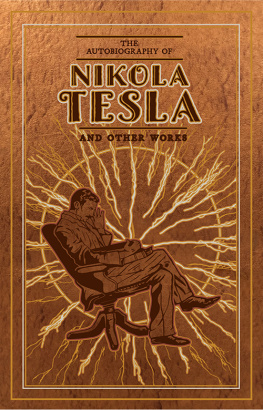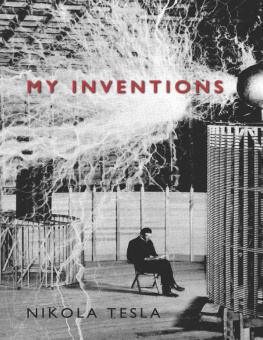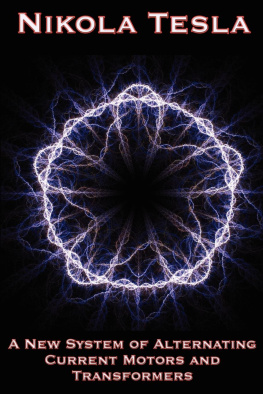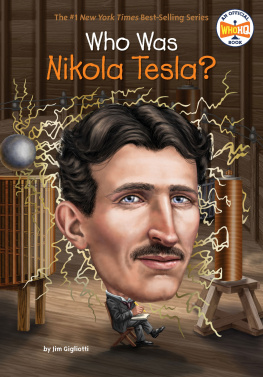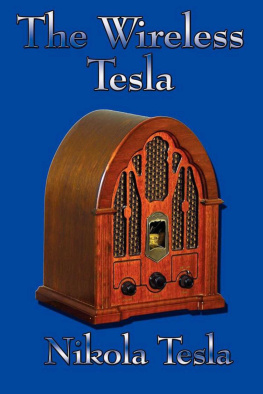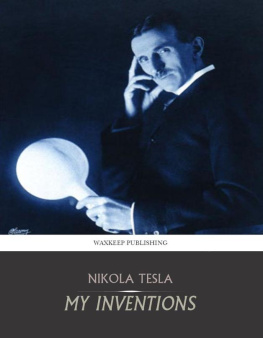Very Truly Yours,
Nikola Tesla
by Nikola Tesla
2007 Wilder Publications
This book is a product of its time and does not reflect the same values as it would if it were written today. Parents might wish to discuss with their children how views on race, gender, sexuality, ethnicity, and interpersonal relations have changed since this book was written before allowing them to read this classic work.
All rights reserved. Printed in the United States of America. No part of this book may be used or reproduced in any manner without written permission except for brief quotations for review purposes only.
Wilder Publications, LLC.
PO Box 3005
Radford VA 24143-3005
ISBN 10: 1-934451-91-6
ISBN 13: 978-1-934451-91-5
First Edition
10 9 8 7 6 5 4 3 2 1
Table of Contents
Mr. Nikola Tesla on Alternating Current Motors
The Losses Due to Hysteresis in Transformers
Swinburnes "Hedgehog" Transformer
Teslas New Alternating Motors
Experiments with Alternating Currents of High Frequency
Alternate Current Motors
Electro-Motors
Phenomena of Currents of High Frequency
Electric Discharge in Vacuum Tubes
Note by Prof. J. J. Thomson
Reply to J. J. Thomsons
The "Drehstrom" Patent
The Ewing High-Frequency Alternator and Parsons Steam Engine
The Physiological and Other Effects of High Frequency Currents
From Nikola Tesla - He Writes about His Experiments in Electrical Healing
Teslas Latest Results: He Now Produces Radiographs At A Distance of More Than Forty Feet
Mr. Tesla on Thermo Electricity
Teslas Latest Advances in Vacuum-tube Lighting. Application of Tubes of High Illuminating Power to Photography and Other Purposes
Tesla on Animal Training by Electricity
Letter to Editor
Tesla Describes His Efforts in Various Fields of Work
Electrical oscillator activity ten million Horsepower Burning atmospheric nitrogen by high frequency discharges twelve million volts
Letter from Nikola Tesla
Electric Autos
Tesla on Subway Dangers
Teslas Reply to Edison
Tesla on the Peary North Pole Expedition
Signaling to Mars A Problem of Electrical Engineering
Tuned Lightning
Teslas Wireless Torpedo
Wireless on Railroads
Nikola Tesla Objects
Mr. Tesla on the Wireless Transmission of Power
Can Bridge the Gap to Mars
Sleep From Electricity
Possibilities of "Wireless"
Tesla on Wireless
My Apparatus, Says Tesla
Nikola Tesla's Forecast for 1908
Mr. Tesla's Vision
Little Airplane Progress
Tesla on Airplanes
How to Signal Mars
What Science May Achieve this Year: New Mechanical Principle for Conservation of Energy
Mr. Tesla on the Future
Tesla and Marconi
Nikola Tesla Tells of Country's War Problems
Tesla Answers Mr. Manierre and Further Explains the Axial Rotation of the Moon
Mr. Nikola Tesla on Alternating Current Motors
Electrical World N. Y. May 25, 1889
To the Editor of The Electrical World:
Sir: About a year ago I had the pleasure of bringing before the American Institute of Electrical Engineers the results of some of my work on alternate current motors. They were received with the interest which novel ideas never fail to excite in scientific circles, and elicited considerable comment. With truly American generosity, for which, on my part, I am ever thankful, a great deal of praise through the columns of your esteemed paper and other journals has been bestowed upon the originator of the idea, in itself insignificant. At that time it was impossible for me to bring before the Institute other results in the same line of thought. Moreover, I did not think it probable considering the novelty of the idea that anybody else would be likely to pursue work in the same direction. By one of the most curious coincidences, however, Professor Ferraris not only came independently to the same theoretical results, but in a manner identical almost to the smallest detail. Far from being disappointed at being prevented from calling the discovery of the principle exclusively my own, I have been excessively pleased to see my views, which I had formed and carried out long before, confirmed by this eminent man, to whom I consider myself happy to be related in spirit, and toward whom, ever since the knowledge of the facts has reached me, I have entertained feelings of the most sincere sympathy and esteem. In his able essay Prof. Ferraris omitted to mention various other ways of accomplishing similar results, some of which have later been indicated by 0. B. Shallenberger, who some time before the publication of the results obtained by Prof. Ferraris and myself had utilized the principle in the construction of his now well known alternate current meter, and at a still later period by Prof. Elihu Thomson and Mr. M. J. Wightman.
Since the original publications, for obvious reasons, little has been made known in regard to the further progress of the invention; nevertheless the work of perfecting has been carried on indefatigably with all the intelligent help and means which a corporation almost unlimited in its resources could command, and marked progress has been made in every direction. It is therefore not surprising that many unacquainted with this fact, in expressing their views as to the results obtained, have grossly erred.
In your issue of May 4, I find a communication from the electricians of Ganz & Co., of Budapest, relating to certain results observed in recent experiments with a novel form of alternate current motor. I would have nothing to say in regard to this communication unless it were to sincerely congratulate these gentlemen on any good results which they may have obtained, but for the article, seemingly inspired by them, which appeared in the London Electrical Review of April 26, wherein certain erroneous views are indorsed and some radically false assertions made, which, though they may be quite unintentional, are such as to create prejudice and affect material interests.
As to the results presented, they not only do not show anything extraordinary, but are, in fact, considerably below some figures obtained with my motors a long time ago. The main stress being laid upon the proposition between the apparent and real energy supplied, or perhaps more directly, upon the ratio of the energy apparently supplied to, and the real energy developed by, the motor, I will here submit, with your permission, to your readers, the results respectively arrived at by these gentlemen and myself.
Energy apparently
supplied in watts. | Work performed in watts. | Ratio of energy apparently supplied to the real energy developed. |
Ganz & Co. | Westinghouse Co. | Ganz & Co. | Westinghouse Co. | Ganz & Co. | Westinghouse Co. |
18,000 | 21,840 | 11,000 | 17,595 | 0.611 | 0.805 |
24,200 | 30,295 | 14,600 | 25,365 | 0.603 | 0.836 |
29,800 | 43,624 | 22,700 | 36,915 | 0.761 | 0.816 |
...... | 56,800 | ...... | 48,675 | ..... | 0.856 |
...... | 67,500 | ...... | 59,440 | ..... | 0.88 |
...... | 79,100 | ...... | 67,365 | ..... | 0.851 |
If we compare these figures we will find that the most favorable ratio in Ganz & Cos motor is 0.761, whereas in the Westinghouse, for about the same load, it is 0.836, while in other instances, as may be seen, it is still more favorable. Notwithstanding this, the conditions of the test were not such as to warrant the best possible results.
Next page

